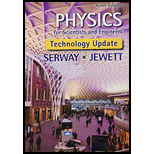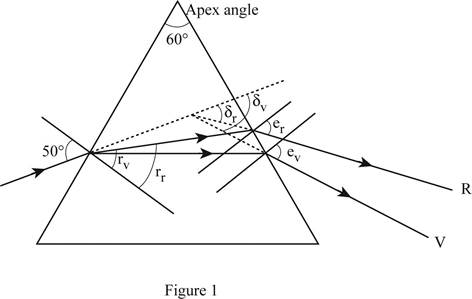
Concept explainers
The angular spread of visible light passing through a prism.
Answer to Problem 35.39P
The angular spread of visible light passing through a prism is
Explanation of Solution
Given info: The index of refraction for violet light in silica flint glass is
The figure of light ray passing through the prism is shown as below,

The expression of the Snell’s law is,
Here,
For the red color:
Consider the angle of refraction on the first face of the prism is
Substitute
Thus, the angle of refraction on the first face of the prism is
The angle of incidence on the second face of the prism is,
Here,
Substitute
Consider the angle of refraction on the second face of the prism is
Substitute
Thus, the angle of refraction on the second face of the prism is
The angle of deviation is,
Here,
Substitute
Thus, the angle of deviation for red color is
For the violet color:
Consider the angle of refraction on the first face of the prism is
Substitute
Thus, the angle of refraction on the first face of the prism is
The angle of incidence on the second face of the prism is,
Substitute
Consider the angle of refraction on the second face of the prism is
Substitute
Thus, the angle of refraction on the second face of the prism is
The angle of deviation is,
Substitute
Thus, the angle of deviation for violet color is
The angular spread of visible light passing through a prism is,
Substitute
Conclusion:
Therefore, the angular spread of visible light passing through a prism is
Want to see more full solutions like this?
Chapter 35 Solutions
Bundle: Physics for Scientists and Engineers, Technology Update, 9th Loose-leaf Version + WebAssign Printed Access Card, Multi-Term
- 8. With the aid of a diagram draw the following electric circuit and use the resistor as the load, (a) Closed circuit (b) Open circuitarrow_forwardLab 8 Part 3 PHET Wave Interface simulation. I am having trouble with this part of the lab.arrow_forwardMick and Rick are twins born on Earth in the year 2175. Rick grows up to be an Earth-bound robotics technician while Mick becomes an intergalactic astronaut. Mick leaves the Earth on his first space mission in the year 2200 and travels, according to his clock, for 10 years at a speed of 0.75c. Unfortunately, at this point in his journey, the structure of his ship undergoes mechanical breakdown and the ship explodes. How old is Rick when his brother dies?arrow_forward
 Physics for Scientists and EngineersPhysicsISBN:9781337553278Author:Raymond A. Serway, John W. JewettPublisher:Cengage Learning
Physics for Scientists and EngineersPhysicsISBN:9781337553278Author:Raymond A. Serway, John W. JewettPublisher:Cengage Learning Physics for Scientists and Engineers with Modern ...PhysicsISBN:9781337553292Author:Raymond A. Serway, John W. JewettPublisher:Cengage Learning
Physics for Scientists and Engineers with Modern ...PhysicsISBN:9781337553292Author:Raymond A. Serway, John W. JewettPublisher:Cengage Learning Physics for Scientists and Engineers: Foundations...PhysicsISBN:9781133939146Author:Katz, Debora M.Publisher:Cengage Learning
Physics for Scientists and Engineers: Foundations...PhysicsISBN:9781133939146Author:Katz, Debora M.Publisher:Cengage Learning College PhysicsPhysicsISBN:9781305952300Author:Raymond A. Serway, Chris VuillePublisher:Cengage Learning
College PhysicsPhysicsISBN:9781305952300Author:Raymond A. Serway, Chris VuillePublisher:Cengage Learning Principles of Physics: A Calculus-Based TextPhysicsISBN:9781133104261Author:Raymond A. Serway, John W. JewettPublisher:Cengage Learning
Principles of Physics: A Calculus-Based TextPhysicsISBN:9781133104261Author:Raymond A. Serway, John W. JewettPublisher:Cengage Learning Physics for Scientists and Engineers, Technology ...PhysicsISBN:9781305116399Author:Raymond A. Serway, John W. JewettPublisher:Cengage Learning
Physics for Scientists and Engineers, Technology ...PhysicsISBN:9781305116399Author:Raymond A. Serway, John W. JewettPublisher:Cengage Learning





